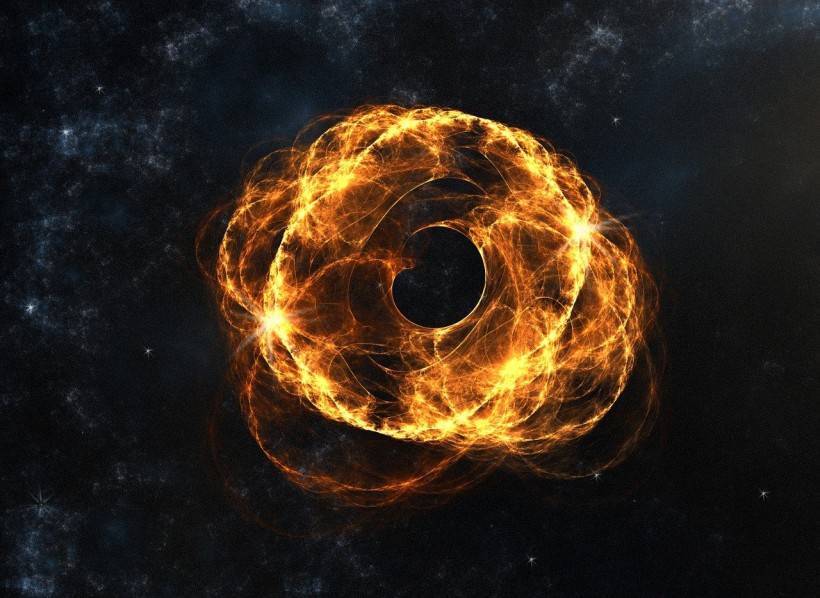Astronomers, led by Newcastle and Durham Universities, discovered a strong link between dust around supermassive black holes and radio emissions in bright galaxies. Using data from Dark Energy Spectroscopic Instrument (DESI), a large-scale survey, they found that dustier and redder quasars had stronger radio emissions than dust-free blue ones.
The findings of the study, titled "A striking relationship between dust extinction and radio detectionin DESI QSOs: evidence for a dusty blow-out phase in red QSOs," are published in the Monthly Notices of the Royal Astronomical Society.

Dusty Supermassive Black Holes Illuminate Radio Emission in Galaxies
Understanding Nature of Red Quasars
Galaxies typically host supermassive black holes at their centers, including the Milky Way galaxy. These black holes, millions to billions of times the mass of the Sun, become highly active when surrounded by abundant material.
The most powerful of these active galaxies are known as quasars, among the Universe's brightest objects. Most quasars appear blue due to the intense matter swirling around the central black hole, emitting bright light in optical and ultraviolet wavelengths. However, a significant portion of quasars appears red, a phenomenon not yet fully understood.
To probe these red quasars' physics, astronomers rely on spectroscopic measurements, which analyze quasar light at various wavelengths. The quasar's spectral shape can reveal the extent of dust enveloping its central region.
Additionally, studying radio emissions from quasars helps understand the supermassive black hole's activity, such as whether it generates powerful "winds" or "jets" influencing the surrounding galaxy.
Researchers from Durham and Newcastle Universities examined around 35,000 quasars, extremely bright galaxies powered by supermassive black holes. They noticed that quasars with more dust appeared redder, while those with little dust looked bluer.
Furthermore, they found a strong connection between the amount of dust around supermassive black holes and the strength of radio emissions in these redder, bright galaxies.
This correlation likely results from powerful gas outflows driven away from the supermassive black hole, colliding with surrounding dust and generating shocks and radio emissions.
Over time, these outflows disperse the central region's dust and gas, transforming the quasar into a blue one with weaker radio emissions. This research supports the idea that red quasars represent a younger, "blow-out" phase in galaxy evolution, offering compelling evidence that they play a crucial role in how galaxies develop.
READ ALSO: Extragalactic Quasars: New Research Finds Easier Method to Locate Rare Black Hole Regulators
Link Between the Dust and Strength of Radio Emission
Dr Victoria Fawcett of Newcastle University and the lead author of the study expressed excitement about the high-quality DESI data, which unveiled thousands of previously rare red quasars.
The study establishes a strong connection between the presence of dust in quasars and their radio emissions, contributing crucial pieces to the red quasar puzzle and enhancing our comprehension of galaxy evolution.
This relationship between reddening and radio emissions likely arises from forceful gas outflows propelled from supermassive black holes, colliding with surrounding dust and generating shocks and radio signals. Over time, these outflows disperse the central galaxy region's dust and gas, revealing a blue quasar with weakened radio emissions.
This aligns with the notion that red quasars represent a youthful "blow-out" phase in galaxy evolution, suggesting their significance in understanding galaxy development.
However, questions remain, such as whether black hole winds or radio jets primarily cause this heightened radio emission in red quasars. As the DESI red quasar dataset continues to expand during the survey's forthcoming years, Dr. Fawcett anticipates that we will soon attain a comprehensive understanding of the nature of red quasars.
RELATED ARTICLE: Rare Merger of Trio Quasars Leads to the Formation of Ultramassive Black Hole; Resultant Cosmic Monster is 300 Billion Times More Massive Than the Sun
Check out more news and information on Space in Science Times.














